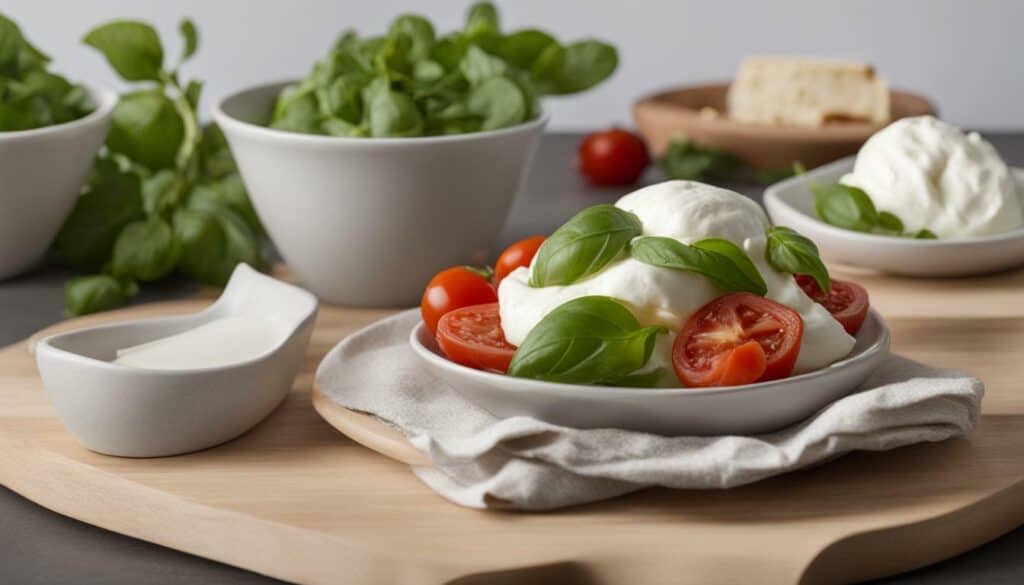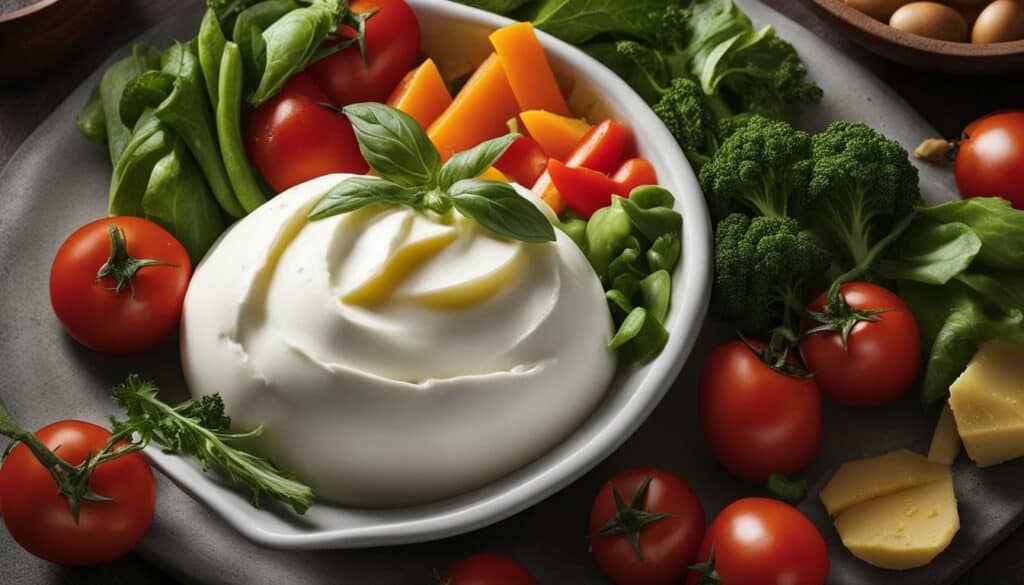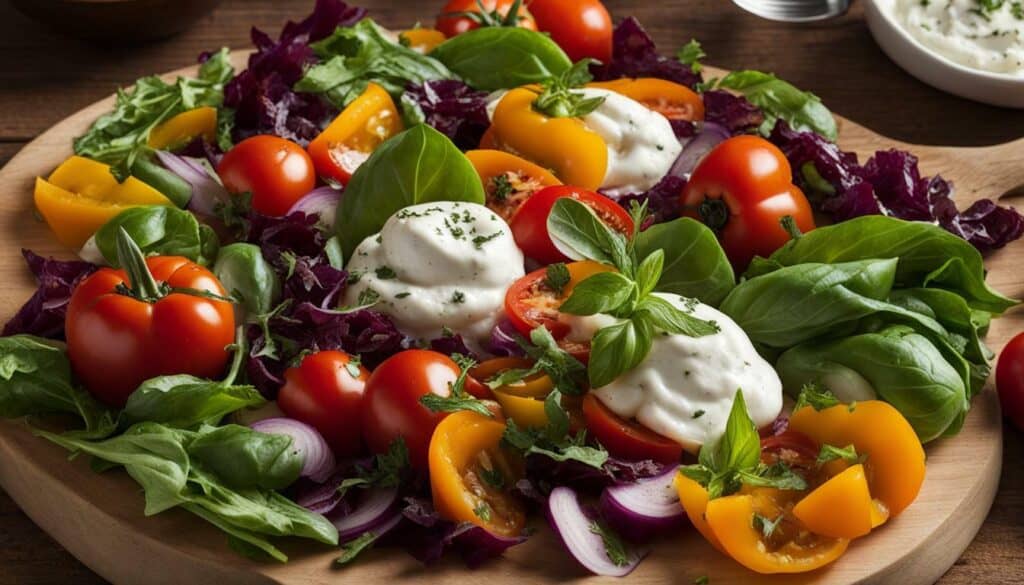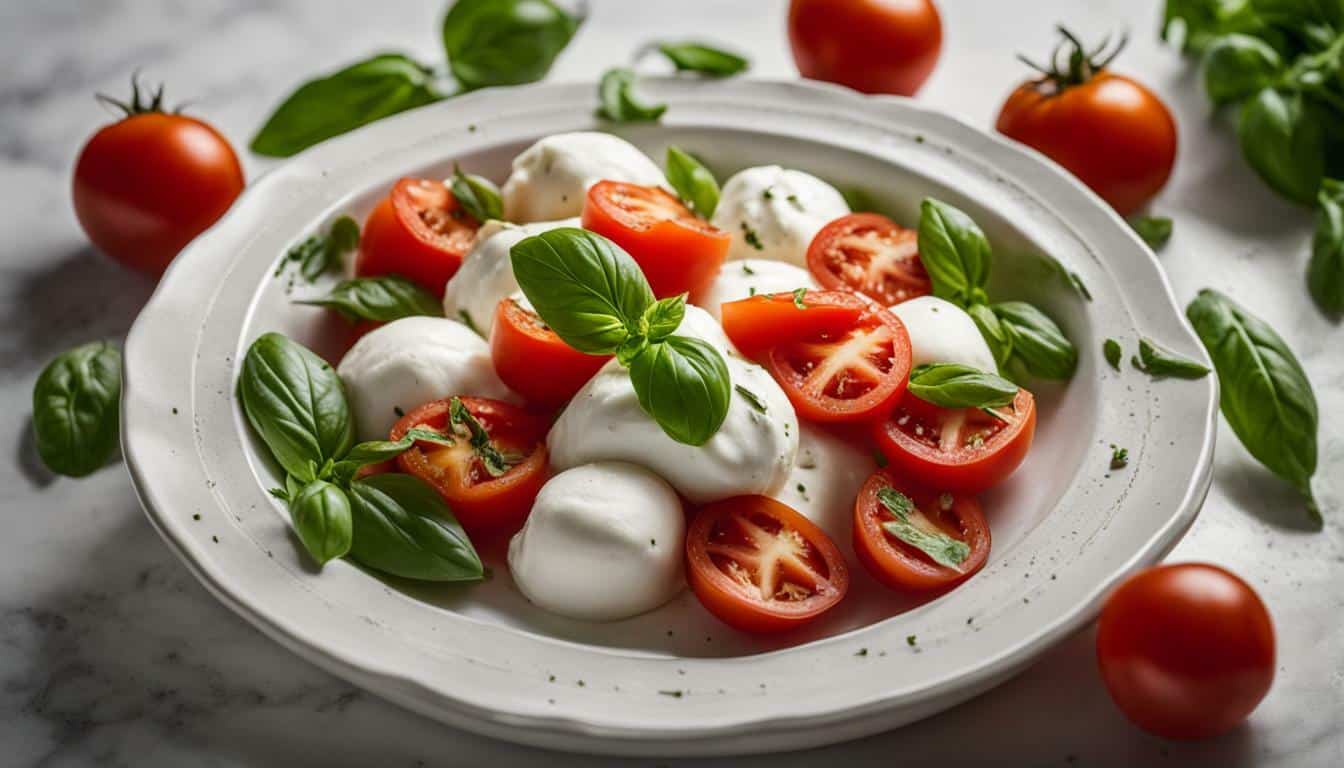Are you curious about the nutrition facts of burrata cheese and how it can fit into your healthy lifestyle? Burrata is a creamy Italian cheese made from mozzarella and cream. It offers a rich and indulgent flavor that pairs well with a variety of dishes. However, it is important to understand its nutritional composition and make informed choices when incorporating it into your diet.
Key Takeaways:
- Burrata cheese is high in calories, with approximately 100-120 calories per ounce.
- The cheese is primarily composed of fat, containing around 7-8 grams per ounce.
- Burrata provides a moderate amount of protein.
- Individuals with lactose intolerance should exercise caution when consuming burrata due to its lactose content.
- Pregnant women can safely enjoy pasteurized burrata as part of a balanced diet.
What is Burrata Cheese and its Nutritional Composition?
Burrata cheese is a creamy Italian cheese made from mozzarella and cream, and its nutritional composition is worth exploring. This indulgent cheese is beloved for its soft, buttery texture and rich, decadent flavor. But what exactly does it bring to the table in terms of nutrition?
When it comes to burrata cheese nutrition facts, it’s important to note that this cheese is quite high in calories. In fact, each ounce of burrata typically contains around 100-120 calories. This is primarily due to its high fat content, which ranges from 7 to 8 grams per ounce. While fat is an essential macronutrient that provides energy and aids in nutrient absorption, it’s crucial to consume it in moderation.
On the protein front, burrata cheese provides a moderate amount. Protein is essential for building and repairing tissues, supporting immune function, and creating enzymes and hormones. Incorporating protein-rich foods like burrata into your diet can help you feel more satisfied and maintain muscle mass.
| Nutrient | Amount per ounce |
|---|---|
| Calories | 100-120 |
| Fat | 7-8 grams |
| Protein | Moderate amount |
Despite its deliciousness, burrata cheese may not be suitable for everyone. It contains lactose, a type of sugar found in milk, which can be problematic for individuals with lactose intolerance. If you have trouble digesting lactose, it’s best to exercise caution when consuming burrata.
On the other hand, pregnant women can safely enjoy burrata cheese as long as it’s made from pasteurized milk. Pasteurization eliminates harmful bacteria and pathogens, making the cheese safe for consumption during pregnancy.
Burrata cheese is also a good source of calcium, a mineral that plays a vital role in maintaining strong bones and teeth, as well as supporting proper nerve function and muscle contraction. Additionally, burrata can be incorporated into a keto or low-carb diet due to its low carbohydrate content. However, individuals with high cholesterol should limit their intake, as burrata is a rich source of saturated fat.

Pairing burrata with fresh vegetables and lean proteins is an excellent way to create a healthier meal. The creamy texture and rich flavor of burrata complement a wide variety of ingredients, adding a touch of indulgence to a nutritious plate.
In conclusion, burrata cheese is a delicious and decadent option, but it’s important to consume it in moderation. By understanding the nutritional composition of burrata, you can make informed choices and incorporate it into a balanced diet.
Burrata Calories and Fat Content
If you’re concerned about calories and fat in your diet, it’s important to understand how much burrata cheese contributes. Burrata is a creamy Italian cheese made from mozzarella and cream. While it is undeniably delicious, it is also high in calories and fat. In fact, each ounce of burrata cheese contains approximately 100-120 calories and 7-8 grams of fat.
Now, let’s break it down further. The calorie content in burrata is primarily due to its high fat content. This high fat content is what gives burrata its smooth and creamy texture. So, while it may be a heavenly treat for your taste buds, it’s important to enjoy it in moderation.
To put it into perspective, a typical serving of burrata cheese, which is about 2 ounces, can contain around 200-240 calories and 14-16 grams of fat. Keep in mind that these numbers can vary slightly depending on the brand and specific recipe. So, if you’re watching your calorie intake or trying to manage your fat consumption, it’s essential to be mindful of the portion sizes.
That being said, burrata can still be enjoyed as part of a balanced diet. It’s all about finding that sweet spot where you can savor its rich flavors without overindulging. Pair it with fresh vegetables or lean proteins to create a healthier meal and balance out the higher calorie and fat content. As always, moderation is key!

| Nutrient | Amount per Ounce |
|---|---|
| Calories | 100-120 |
| Fat | 7-8 grams |
| Protein | 3-4 grams |
| Carbohydrates | 1-2 grams |
Protein Content in Burrata
Protein is an essential nutrient and understanding how burrata cheese contributes to your daily intake is valuable. As a creamy Italian cheese made from mozzarella and cream, burrata offers a moderate amount of protein alongside its rich and indulgent taste. A 1-ounce serving of burrata contains approximately 4-5 grams of protein, making it a satisfying addition to your meals.
While burrata may not be as protein-dense as some other cheeses, it still plays a role in supporting muscle growth and repair. Protein is also important for maintaining a feeling of fullness, which can aid in weight management. When combined with a variety of protein sources, such as lean meats, legumes, and nuts, burrata can contribute to a balanced and nutritious diet.
To put the protein content of burrata into perspective, let’s compare it to other popular food sources. An ounce of chicken breast provides around 9 grams of protein, while a similar amount of Greek yogurt offers 7-8 grams. However, it’s worth noting that burrata is not a low-calorie cheese, as it contains around 100-120 calories per ounce. So, enjoy burrata in moderation and be mindful of its calorie content.

In conclusion, while burrata may not be the most protein-rich option, it can still contribute to your daily protein needs. Including burrata in your diet can add flavor and variety to your meals, especially when paired with fresh vegetables and lean proteins. Remember to enjoy burrata in moderation as part of a balanced eating plan that meets your nutritional requirements.
Lactose and Burrata: Who Should Be Cautious?
For individuals with lactose intolerance, it’s important to be aware of the lactose content in burrata cheese. While lactose levels can vary depending on the specific brand or recipe, burrata is generally made from cow’s milk, which naturally contains lactose.
People with lactose intolerance have difficulty digesting lactose, the sugar found in milk and dairy products. Consuming foods high in lactose can cause digestive discomfort such as bloating, gas, and diarrhea. However, it’s worth noting that the lactose content in burrata cheese may be lower compared to other types of dairy cheese, as some of the lactose is removed during the cheese-making process.
To enjoy burrata without experiencing discomfort, individuals with lactose intolerance can try consuming smaller portions or pairing it with lactase supplements, which help break down lactose. Alternatively, there are lactose-free or lactose-reduced versions of burrata available in some markets, which can be a suitable option for those with lactose intolerance.

Opting for lactose-free burrata can provide individuals with lactose intolerance the chance to enjoy the creamy, indulgent flavors without the digestive discomfort. Lactose-free burrata is made by adding lactase enzymes to the milk during the cheese-making process, effectively converting lactose into more easily digestible forms.
By choosing lactose-free burrata, individuals with lactose intolerance can still savor the rich taste and texture of this Italian cheese while minimizing the risk of unpleasant digestive symptoms. It’s essential to check the packaging and labels to ensure the burrata is indeed lactose-free and suitable for lactose-intolerant individuals.
Table: Nutritional composition of burrata cheese per 1 ounce (28g) serving.
It’s also important to remember that lactose intolerance varies from person to person, and some individuals may be able to tolerate small amounts of lactose without experiencing discomfort. If you’re unsure about your tolerance levels, it’s always best to consult with a healthcare professional or a registered dietitian.
Burrata and Pregnancy
If you’re expecting, you may wonder if burrata cheese is a safe and nutritious option for you. The good news is that pregnant women can safely consume pasteurized burrata, as long as it is made from pasteurized milk. Pasteurization kills harmful bacteria, making the cheese safe for consumption during pregnancy.
Burrata is not only safe but also provides several health benefits for expectant mothers. It is rich in calcium, which plays a crucial role in the development of your baby’s bones and teeth. Calcium also supports your own bone health, as your body’s demand for this mineral increases during pregnancy.
In addition to calcium, burrata cheese is a good source of protein. Protein is essential for the growth and repair of tissues in both you and your baby. Including burrata in your diet can help ensure you meet your protein requirements during pregnancy.
However, it’s important to consume burrata in moderation, as it is a high-calorie cheese. Each ounce of burrata contains around 100-120 calories and is primarily composed of fat, with 7-8 grams per ounce. To maintain a balanced diet, it’s best to enjoy burrata as part of a meal with other nutritious foods, such as fresh vegetables and lean proteins. This will help you meet your nutritional needs while managing your overall calorie intake.

- Pregnant women can safely consume pasteurized burrata made from pasteurized milk.
- Burrata is rich in calcium, supporting the development of your baby’s bones and teeth.
- It is also a good source of protein, important for tissue growth and repair.
- Enjoy burrata in moderation as part of a balanced meal with other nutritious foods.
Table
| Nutrient | Amount per ounce of Burrata cheese |
|---|---|
| Calories | 100-120 |
| Fat | 7-8 grams |
| Protein | Moderate |
| Lactose | Present (exercise caution if lactose intolerant) |
| Calcium | Rich source |
Calcium Content in Burrata
Calcium is crucial for maintaining strong bones, and burrata cheese can be a tasty source of this essential mineral. A 1-ounce serving of burrata provides approximately 200 milligrams of calcium, which is about 20% of the daily recommended intake for adults. Calcium plays a vital role in bone health, helping to build and maintain strong bones throughout life. Incorporating calcium-rich foods like burrata into your diet can contribute to overall bone strength and reduce the risk of osteoporosis.
Not only does burrata offer a good dose of calcium, but it is also a delicious and versatile cheese. It has a creamy texture and a mild, slightly tangy flavor, making it a popular choice in many dishes. Whether enjoyed on its own, paired with fresh fruits or vegetables, or used in recipes, burrata can elevate the taste and nutritional value of meals.
To make the most of the calcium content in burrata, try incorporating it into salads with leafy greens, tomatoes, and cucumbers. The combination of crunchy vegetables and creamy burrata creates a delightful contrast of textures. You can also use burrata as a topping for roasted vegetables or spread it on whole grain bread for a tasty and nutrient-packed snack.
| Calories per ounce | Fat per ounce (grams) | Protein per ounce (grams) | Calcium per ounce (milligrams) |
|---|---|---|---|
| 100-120 | 7-8 | 2-3 | 200 |
So, if you’re looking to boost your calcium intake while enjoying a delicious cheese, burrata can be a great choice. Just remember to consume it in moderation along with a variety of other nutrient-dense foods to maintain a balanced diet. Bon appétit!

If you follow a specific dietary plan or have dietary restrictions, burrata cheese can still have a place on your plate. Despite its rich and creamy texture, burrata can be enjoyed in moderation as part of a balanced diet. Here’s a closer look at how burrata fits into different dietary considerations.
Keto and Low-Carb Diets
If you’re following a keto or low-carb diet, you’ll be pleased to know that burrata can be incorporated into your meals. With its high fat content and low carbohydrate content, burrata is a suitable choice for those limiting their carb intake. Pair it with fresh vegetables like tomatoes, basil, and arugula for a delicious and satisfying low-carb meal.
High Cholesterol
If you have high cholesterol, it’s important to monitor your intake of high-fat foods like burrata. While burrata can provide essential nutrients such as calcium and protein, it’s best to enjoy it in moderation. Opt for reduced-fat versions or limit your portion size to maintain a healthy balance in your diet.
Lactose Intolerance
Burrata contains lactose, a natural sugar found in milk products. If you have lactose intolerance, you may experience digestive discomfort after consuming burrata or other dairy products. However, some individuals with lactose intolerance find that they can tolerate small amounts of burrata without adverse effects. It’s important to listen to your body and consult with a healthcare professional to determine your personal tolerance level.
Summary
In summary, burrata cheese can still be enjoyed even if you have specific dietary restrictions. It can be a part of a keto or low-carb diet when paired with fresh vegetables, and individuals with lactose intolerance may be able to tolerate small amounts. However, those with high cholesterol should consume burrata in moderation. Remember, as with any food, it’s best to listen to your body and make choices that align with your specific dietary needs and goals.

| Nutrient | Amount per Ounce |
|---|---|
| Calories | 100-120 |
| Fat | 7-8 grams |
| Protein | 2-3 grams |
| Lactose | Contains lactose |
Pairing Burrata with Healthy Foods
Creating a well-rounded meal with burrata cheese involves combining it with wholesome ingredients for maximum health benefits. This creamy Italian cheese pairs exceptionally well with fresh vegetables and lean proteins, making it a versatile choice for those seeking a nutritious and flavorful dish.
To begin, consider incorporating a variety of colorful vegetables into your meal. Whether it’s crisp lettuce, juicy tomatoes, or vibrant peppers, these vegetables not only add a visual appeal but also provide a range of essential vitamins and minerals. Combine them with burrata cheese for a refreshing salad or use them as a topping for bruschetta, adding a burst of flavor that perfectly complements the creamy texture of the cheese.
Lean proteins such as grilled chicken, poached fish, or roasted tofu can also be paired with burrata to create a satisfying and nutritious main course. The protein content in these ingredients helps promote satiety and muscle growth, while the creamy burrata adds a luxurious touch to the dish.
| Ingredients | Benefits |
|---|---|
| Colorful vegetables (lettuce, tomatoes, peppers) | Rich in vitamins, minerals, and antioxidants |
| Grilled chicken, poached fish, or roasted tofu | Lean sources of protein |
Experimenting with different flavor combinations is key to keeping your meals exciting. You can also try adding fresh herbs like basil or arugula to enhance the taste and nutritional value of your dish. The possibilities are endless when it comes to pairing burrata cheese with healthy foods, allowing you to create a well-balanced and satisfying meal that nourishes both your body and your taste buds.
Quotes
“Burrata cheese adds a creamy indulgence to any meal, and when paired with fresh and nutritious ingredients, it creates a harmonious balance of flavors.” – Nutritionist Sarah Smith

Understanding the appropriate portion size of burrata cheese can help you enjoy its creamy goodness while staying mindful of your overall calorie intake. Burrata is a rich and indulgent cheese, so it’s important to consume it in moderation as part of a balanced diet.
On average, a serving size of burrata cheese is about 1 ounce or 28 grams. This amount typically provides around 100-120 calories, with the majority coming from fat. It’s important to note that burrata is not considered a low-calorie cheese, so if you’re watching your calorie intake, it’s best to savor it as a treat rather than a staple in your daily meals.
When enjoying burrata, it’s also a good idea to pair it with other nutrient-dense foods. Consider adding fresh vegetables like tomatoes, basil, and arugula to create a colorful and satisfying salad. You can also add a lean protein like grilled chicken or shrimp to make it a more complete meal. This way, you’re not only enhancing the flavors but also adding important vitamins, minerals, and additional protein to your plate.

When entertaining or indulging in a cheese platter, it’s essential to create a balance of flavors, textures, and nutrients. Here’s a simple guide to crafting a delectable burrata cheese platter:
- Start with a base of mixed greens or arugula.
- Add a variety of fresh fruits, such as sliced figs, grapes, or berries, for a burst of natural sweetness.
- Include a selection of cured meats, like prosciutto or salami, to provide savory notes and additional protein.
- Place the creamy burrata cheese in the center of the platter, surrounded by the colorful fruits and meats.
- Sprinkle the dish with fresh herbs like basil or mint for added fragrance.
- Drizzle a high-quality balsamic glaze or extra virgin olive oil over the cheese and greens for a touch of tanginess.
Remember, while enjoying a delicious burrata cheese platter, it’s essential to listen to your body’s hunger and fullness cues. Slow down, savor each bite, and focus on the pleasure and satisfaction that comes from mindful eating.
| Nutrition Facts | Per 1 oz (28g) serving |
|---|---|
| Calories | 100-120 |
| Total Fat | 7-8g |
| Protein | 4-5g |
By keeping these serving size recommendations in mind and incorporating burrata cheese into a well-balanced meal or cheese platter, you can enjoy its creamy indulgence without compromising your health and wellness goals.
Making the Most of Burrata in Your Diet
By considering the nutritional aspects of burrata cheese, you can make informed choices and delight in its taste while supporting your overall well-being. While it is true that burrata is a higher-calorie cheese, with around 100-120 calories per ounce, it can still be enjoyed in moderation as part of a balanced diet. One of the best things about burrata is its creamy texture, which adds a luxurious touch to any dish.
Pairing burrata cheese with fresh vegetables and lean proteins can create a healthier meal that satisfies both your cravings and your nutritional needs. For a light and refreshing option, serve burrata with vibrant heirloom tomatoes, basil, and a drizzle of balsamic vinegar. The combination of flavors and textures will leave you feeling satisfied without weighing you down.
If you’re following a keto or low-carb diet, burrata can be a great addition. It is low in carbohydrates and high in fat, making it a suitable choice for those looking to reduce their carb intake. However, it’s essential to note that burrata is still high in fat, with around 7-8 grams per ounce, so individuals with high cholesterol should consume it in moderation.

| Nutrient | Amount (Per Ounce) |
|---|---|
| Calories | 100-120 |
| Fat | 7-8 grams |
| Protein | Moderate amount |
| Lactose | Present |
| Calcium | Rich source |
By incorporating burrata cheese into your diet in a mindful way, you can savor its indulgent taste and benefit from its nutritional value. Remember to enjoy it in moderation and balance it with other nutrient-dense foods to maintain a healthy lifestyle.
Conclusion
Exploring and understanding the nutritional profile of burrata cheese can empower you to make informed choices for a healthier lifestyle.
Burrata, a creamy Italian cheese made from mozzarella and cream, is a delicious addition to any meal. However, it’s important to be aware of its nutritional composition. With around 100-120 calories per ounce, burrata is considered high in calories. It is primarily composed of fat, with 7-8 grams per ounce, and provides a moderate amount of protein.
While burrata is not considered a low-calorie cheese, it can still be enjoyed in moderation as part of a balanced diet. Individuals with lactose intolerance should exercise caution, as burrata contains lactose. However, pregnant women can safely consume pasteurized burrata.
On the bright side, burrata is rich in calcium, making it a great choice for maintaining bone health. It can also be incorporated into a keto or low-carb diet, but individuals with high cholesterol should limit their intake.
To create a healthier meal, consider pairing burrata with fresh vegetables and lean proteins. This combination will provide a good balance of nutrients and flavors.
Remember, moderation is key. By understanding the nutritional profile of burrata cheese and making mindful choices, you can enjoy this creamy delight while maintaining a healthier lifestyle.
FAQ
Q: What is the nutritional composition of burrata cheese?
A: Burrata cheese is a creamy Italian cheese made from mozzarella and cream. It is high in calories, with around 100-120 calories per ounce. The cheese is primarily composed of fat, with 7-8 grams per ounce, and provides a moderate amount of protein.
Q: Is burrata a low-calorie cheese?
A: No, burrata is not considered a low-calorie cheese. It should be consumed in moderation as part of a balanced diet.
Q: Does burrata contain lactose?
A: Yes, burrata contains lactose. Individuals with lactose intolerance should exercise caution when consuming it.
Q: Can pregnant women safely consume burrata?
A: Yes, pregnant women can safely consume pasteurized burrata cheese.
Q: Is burrata rich in calcium?
A: Yes, burrata is rich in calcium, which is beneficial for bone health.
Q: Can burrata be enjoyed as part of a keto or low-carb diet?
A: Yes, burrata can be enjoyed as part of a keto or low-carb diet. However, individuals with high cholesterol should limit their intake due to the cheese’s fat content.
Q: How can I pair burrata with healthier foods?
A: Burrata can be paired with fresh vegetables and lean proteins to create a healthier meal.
Is Burrata Cheese a Healthy Option Compared to Cheese Curds?
When comparing Burrata cheese to cheese curds, it’s important to consider the cheese curds nutritional facts. While both options provide a rich and creamy taste, Burrata cheese tends to be higher in calories, fat, and cholesterol. However, Burrata cheese also offers more protein and calcium. Making an informed decision about which option is healthier ultimately depends on individual dietary needs and preferences.





Leave a Reply